CEPHALOPODS & HUMANS

WORLD FISHERIES & HUMAN CONSUMPTION
CEPHALOPODS ARE AN EXCELLENT PROTEIN SOURCE, they are abundant in many parts of the world and when cooked properly some are very tasty. Consequently they have given rise to many commercial and artisanal fisheries throughout the world’s oceans. From the biomedical perspective, cephalopods have made major contributions to understanding the nervous systems of many animals, including humans. The fields of materials science and engineering have also benefited by using cephalopod models as bio-inspired approaches to creating novel technologies that are useful throughout human society and industry.
The world catch of cephalopods (squid, octopus, and cuttlefish) increased from 3.4 to 4.7 million tons during the period of 1999–2015, reflecting an upward trend that had been occurring for several decades. This trend is partly attributed to the global shift from traditional to non-traditional target species, otherwise known as “fishing down the food web,” when stocks of target species such as fishes become depleted. Cephalopods are prey and/or competitors to many traditional fish species. The total world capture figure has remained relatively steady in the past decade: in 2015 it was valued at 10 billion US dollars.
SQUID & CUTTLEFISH FISHING
Squid fisheries accounted for the majority of the global cephalopod catches: landings in 2015 were 3.5 million tons. Overall about 35 squid species have substantial commercial importance around the world but the majority of catch comes from just a few species. The oceanic ommastrephid squids such as the Humboldt squid Dosidicus gigas, and Argentine shortfin squid Illex argentinus dominate squid fisheries, each providing about 1 million tons annually. Japanese flying squid Todarodes pacificus landings are about 300,000 tons. These ommastrephids are captured at night mostly by using squid jigs (a type of lure with rows of barbless hooks at the bottom) and powerful incandescent lights that attract the squids to the vicinity of the boat. This jig-fishing method exploits a key behavior of these aggressive predators: attraction to motion, which is indicative of live prey (squids are active carnivores). The automated jigging machines have elliptical drums that impart an up-and-down jigging motion that proves very efficient at hooking squids and pulling them swiftly to the boat.

Small-scale fisheries rely on the manual method of landing squids, using a handline.

Typical squid jigs that look like fish or shrimp, both of which squid eat.
Nearshore loliginid squid landings were more than 470,000 tons in 2015. Doryteuthis gahi (South American southern coastlines) and other species such as Doryteuthis pealeii (eastern coast of USA) are captured by trawling. Doryteuthis opalescens (off California) is strongly attracted to lights and captured by modified purse seines as squids aggregate under the lights, while the South African Loligo reynaudii is captured with squid jigs both at night with lights and during the day when they are actively spawning near the seafloor. Each commercial capture method is tailored to the schooling behavior, diel movements, and feeding methods of these highly mobile animals.

A Japanese squid jigging boat with a row of very bright lights and several rollers that are part of automated squid jiggers.
Cuttlefishes are benthic animals captured mainly by bottom trawling and a typical annual landing globally is 440,000 tons. Three quarters of this is taken in Asia, with around 150,000 tons landed in China, and an estimated 100,000 tons landed in India. More than 30 species have been identified as being of interest to fisheries. In Europe and Africa the majority of the catch is the common European cuttlefish Sepia officinalis.
THE OCTOPUS CATCH
Octopus fisheries landed 400,000 tons in 2015, of which 34,000 tons were the common octopus, Octopus vulgaris, on the Sahara Bank, the Atlantic coasts of southern Europe, and in the Mediterranean Sea. About 6,000 tons of Eledone species were landed in Europe and the Mediterranean, and 24,000 tons of Octopus maya were landed in Mexico. The rest was captured worldwide, mainly in Asia. Small-scale artisanal octopus fisheries exist all around the world. Asian countries dominate the market demand for cephalopods. However, restaurants all around the world—especially Europe and even North America—are increasing the menu choices with cephalopod recipes.
DEMAND FOR CEPHALOPODS
Cephalopods are also of use to humans in less noticeable ways. As they are in the middle of the food chain, they are a primary food for many recreational game fish such as marlin, grouper, snapper, and flounder. One example is the highly valuable sport-fishing industry for striped bass along the eastern seaboard of the USA, which uses live squid as bait.
Overall, it is expected that fishing pressure on cephalopods will increase in coming decades. Only a few stocks are at maximum exploitation, and as cephalopods have very short life cycles and most reproduce in large numbers, they have the flexible life history to respond to change relatively well. It is hoped that effective and conservative management practices can be implemented consistently in the future.

Opalescent inshore squid swarming at the surface after being attracted to the bright lights on the boat.

Squid fishing boats in Vietnam at night, shining lights on the water surface to attract the squid.

Thickly aggregated squids, Doryteuthis opalescens, that have been attracted to the surface with bright lights. The large pipe vacuums them into the ship’s hold.

Large marlin that has been hooked by a baited squid.
A RICH HISTORY OF BIOMEDICAL & BIOLOGICAL ADVANCES
THE 1963 NOBEL PRIZE IN PHYSIOLOGY OR Medicine was based largely on the squid giant axon, which provided a model to prove for the first time that nerve cells work by conducting an electrical signal. Every medical student and neuroscientist knows this famous preparation, which is still in use today. Many other cephalopod features have been developed for medical and biological research.
THE SQUID GIANT AXON FOR NEUROSCIENCE
Neuroscience and human medicine have benefited greatly over many decades from the pioneering work performed with the squid giant axon as a model of a single neuron. This “giant axon” is indeed giant: its diameter is approximately 100 times that of the typical human nerve fiber. It was first mistaken for a blood vessel because it was so large. It is broad enough to insert electrodes inside and outside the cell membrane and to measure the complex of ion channels that make up the standard machinery for all nerve fibers, including humans’.
Discovered in the 1930s, this model nerve fiber was studied intensely during the 1950s and 1960s. Many hundreds of research papers have been published on this model preparation. The genome for the squid Doryteuthis pealeii is now being sequenced, and this will open up new avenues of research on what is perhaps the best-known nerve cell in all of biology and human medicine.
So why do squids have a giant axon? In many ways it is an evolutionary dead-end—a genuine oddity in the animal kingdom. Squids are capable of jet propulsion and fast escape; and to squeeze the mantle forcefully for maximum jetting power, the brain needs to transmit signals to the most distant part of its large mantle rapidly, so that all of the mantle contracts in unison. Rapid conduction of electrical signals is achieved by dramatically widening the diameter of the nerve fiber, which cuts down the internal resistance to the electrical signal. Vertebrate animals, including humans, have evolved an insulating myelin sheath (or Schwann cell) around nerve fibers that speeds conduction velocity, so that we do not need unusually wide nerve fibers to operate our bodies and we can fit many more rapidly conducting fibers into our nerves. Fortunately, human ingenuity has found ways to exploit the oddball squid axon to better understand how nerve cells work, or sometimes do not work, as in diseases such as Alzheimer’s.

This very large axon, or nerve fiber, enables fast jet propulsion in squids. Compare its diameter with other surrounding axons.
OCTOPUS MODEL FOR LEARNING & MEMORY
The octopus model for learning and memory is another famous preparation developed in the 1950s by the venerable Prof. J. Z. Young, who, incidentally, first developed and popularized the squid giant axon. He and his colleagues were some of the first to relate specific actions to individual brain lobes, including centers for learning and memory. For the general experimental paradigm, Octopus vulgaris that were trained in the Naples zoological station were able to learn visual discrimination on just the second or third day of training and were shown to produce both short-term and long-term memory, as in many vertebrate animals. Other British colleagues worked out the details of touch learning and its neural bases. These landmark studies stimulated large communities of neuroscientists to study the neural basis of learning and memory in simpler organisms, because the octopus brain was too large and had too many small cells to make a practical model at that time. Curiously, there is now renewed interest in cephalopod learning and memory, with exciting new investigations of spatial learning and even episodic memory, which was thought to be an attribute only of advanced vertebrate animals. There are new methods to reconsider studying cephalopod learning and memory at the cellular and molecular level, and exciting discoveries await us in the near future.

The squid Doryteuthis pealeii, which is commonly used in Woods Hole, Massachusetts, for neuroscience studies of the giant axon.
OCTOPUS & SQUID GENOMES
The first cephalopod genome to be sequenced and annotated was that of Octopus bimaculoides as reported in the journal Nature in 2015. Several remarkable findings were uncovered in this landmark publication. In particular, the genome size is enormous—nearly the size of mouse and human genomes! Hundreds of cephalopod-specific genes were discovered, especially those that showed elevated expression in the skin, the suckers, and the nervous system, all of which support the general consensus that these animals have complex and unique behaviors.
Recent corroborative research also shows that cephalopods edit their nervous system RNA at an astonishing rate to create a vast array of new proteins, more than in any known organism (including humans). By editing RNA, cephalopods gain the flexibility to express those proteins required under a specific set of environmental conditions. However, this comes at a cost: in order to edit their RNA, their rates of DNA-based genome evolution have slowed. The significance of these findings for neuroscience in general and for biomedical applications is now being studied. The genome for the squid Doryteuthis pealeii is due to be sequenced next, and this commercially and biomedically important species also has a huge genome, which was certainly not anticipated. Many aspects of biological study will be advanced with these new genomic data. Another dozen or so cephalopods are in the process of having their genomes sequenced and the next decade will be an exciting time for research.

Octopus bimaculoides with its distinctive blue iridescent ocellus.
BOBTAIL BIOLUMINESCENCE: A BIOMEDICAL MODEL OF SYMBIOSIS
The light organ of the Hawaiian bobtail creates light by recruiting new luminescent bacteria every day so that the bobtail can have vibrant bioluminescence for counter-illumination during the night when it forages. This process has become a major biomedical model of deciphering the molecular conversation that takes place between the host tissue (the light organ) and the symbiont (the luminous Vibrio fischeri). Most vibrio bacteria are pathogenic to animals and humans (as in cholera, which is caused by Vibrio cholerae) but in the bobtail the vibrios form a healthy and normal symbiosis.
What are the fundamental processes that govern a healthy versus a pathogenic association between various animal tissues and environmental bacteria? This question has direct relevance to human health. The squid/bacterial model has uncovered many details that can help to answer it.
Within the wide realm of biology, various other cephalopod model organisms have contributed to our understanding of subjects as wide ranging as aggression, vision, and reproduction. For example, the cuttlefish has proved in the last decade to be an informative model to understand visual perception as it relates to rapid adaptive camouflage.

The Hawaian bobtail Euprymna scolopes with pigmented chromatophores expanded and blue iridescence expressed on its arms.
BIO-INSPIRED MATERIALS SCIENCE & ENGINEERING
CEPHALOPODS CAN DO MANY THINGS THAT humans would like to be able to do, such as change the color or pattern of their clothes, cars, or complexion. This futuristic dream is close to reality given the advances in technology as well as in-depth investigations of the biological processes that enable these capabilities in cephalopods. Even robots with flexible arms based on those of octopuses are being developed for a wide range of uses.
NEW CLASSES OF COLOR-CHANGING MATERIALS
The dynamically changing skin of cephalopods provides a biological model that may have widespread translational value to a variety of human needs and desires. The ways that humans could use this capability are matched only by the imagination. On the trivial side, changing the appearance of our clothing for a changing social scene could create fun and laughter. On a more serious note, hunters, soldiers, or police could make themselves more inconspicuous or conspicuous depending upon the nature of the endeavor. To enable the transition from basic to applied science we must understand how changeable colors and patterns are produced.
In cephalopods, the simplest explanation is that they use elegant combinations of pigments and reflectors in their skin to create the optical illusions for camouflage or communication. Recent discoveries have demonstrated how pigments and reflectors in cephalopods manipulate light at the level of the wavelength of light, thus paving the way for scientists to create novel classes of nanomaterials that could also change color and pattern.
Materials scientists and engineers have joined with biologists to create some prototype skins that are both flexible and changeable in appearance. One such example, shown on the left, is based upon flexible cephalopod skin, and this device is capable of producing black-and-white patterns that spontaneously match those of the surroundings without user input or external measurement. This approach demonstrates a complete set of materials, components, fabrication methods, integration schemes, bio-inspired designs, and coordinated operational modes for adaptive optical electronic sheets.
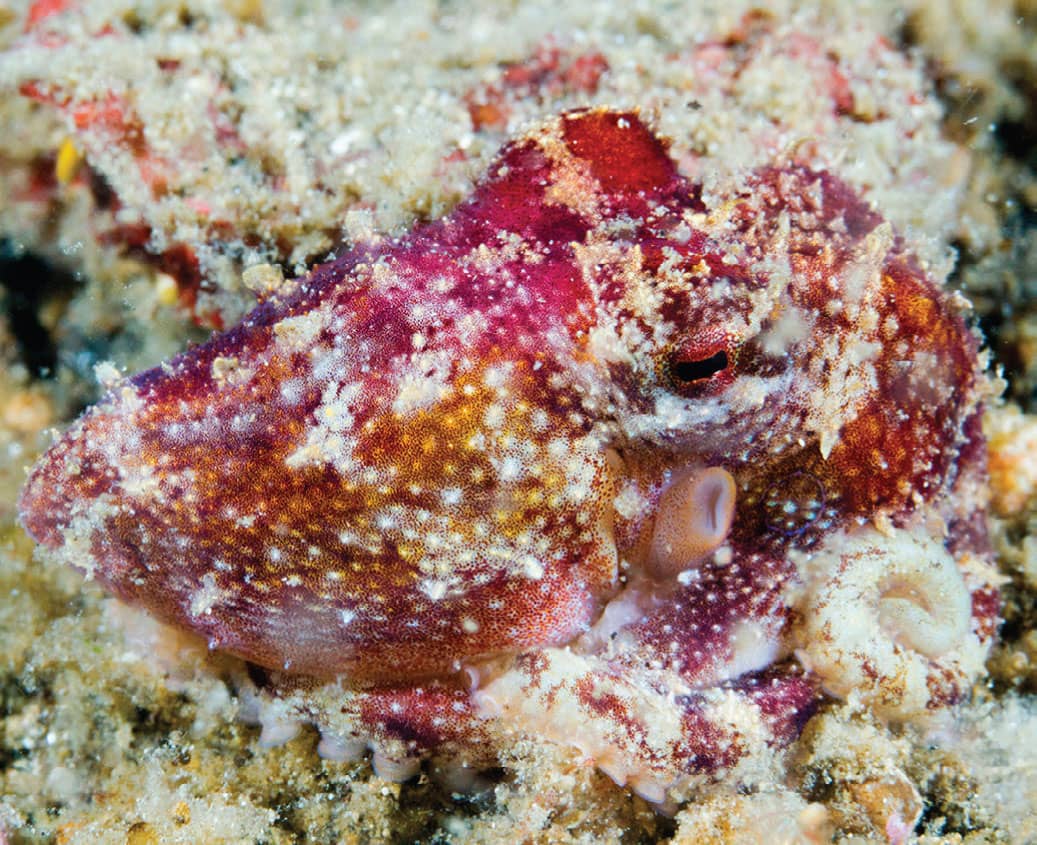
The colorful Octopus mototi has complex skin for camouflage.
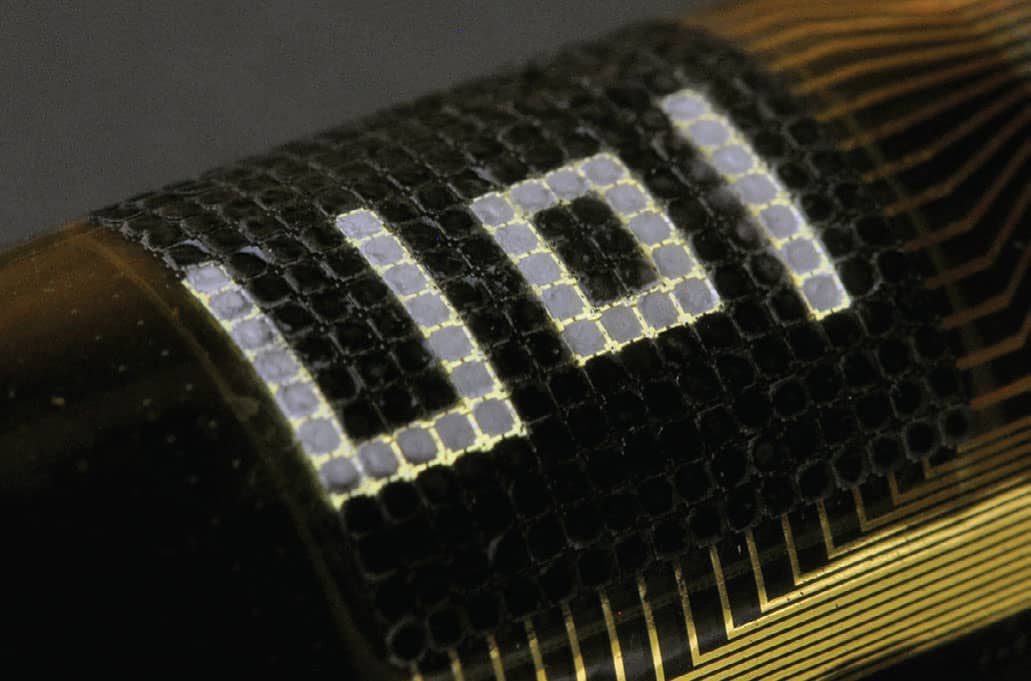
University of Illinois scientists made this flexible material that senses what is under it (in this case the university's acronym) in a compelling demonstration of how cephalopod skin biology can inspire new classes of engineered materials.

The green, blue, and silver colors in this squid’s skin are reflections from iridophores, many of which are turned on and tuned to different colors by nerve fibers. Fabrication of artificial materials based on these biophotonic studies are underway.
The beautiful iridescence that is found in the skin of almost all cephalopods is produced by a novel protein found only in cephalopods, called reflectin. This remarkable protein can dynamically change its conformation to turn iridescence on or off, and can even tune its color across all of the rainbow’s spectrum. Materials scientists have extracted this protein and, to their surprise, the protein molecules self-organized themselves into thin films and reflected light, paving the way to future optical devices including fiber optics.
The reflectin protein has also been engineered into thin films that can be dynamically tuned over more than 600 nanometers in bandwidth (humans can see across a 300-nanometer range, from 400 to 700 nanometers). This tunability allows the films to reversibly disappear and reappear when visualized with an infrared camera, so leading the way to controllable camouflage coatings on a variety of surfaces.
SOFT ROBOTICS
Robotic engineering has also profited from imitating the soft, flexible, yet strong arms of octopuses. Whole robots that can move in constrained and twisted environments (such as collapsed buildings) are in demand, and research groups in Italy have designed and built octopus-inspired robots that are gaining these capabilities.
A single robotic arm appendage with multiple degrees of bending, twisting, and extension is sought for medical applications, and prototypes of such devices are being tested. For example, a European team of collaborators has used the octopus arm as a model to develop what they call “Stiffness controllable flexible and learn-able manipulator for surgical operations” or STIFF-FLOP. Their approach is to combine artificial cognition and robotics to design and test more flexible devices that can move, deform, and change stiffness for minimally invasive surgery (via endoscopy) and other medical applications.

This scanning electron microscope image of octopus suckers shows some of the intracacy of their morphology. Each sucker also has thousands of sensory receptors for touch and taste.
SUCKERS FOR FLEXIBLE ATTACHMENT DEVICES
Cephalopods have suckers on their arms and tentacles and there is substantial variety in their morphology and functionality. The octopus sucker is a complex organ that attaches forcefully to wet, smooth, or rough surfaces of great diversity. Engineers and biologists are measuring their structure and mechanical properties and beginning to build a new generation of attachment devices that are pliable to many terrestrial and manufactured substrate profiles whether wet or dry. These will be useful on robotic arms among other devices.
Squid suckers have an unusual feature that enhances their ability to hold wriggling slippery prey—that is, to counteract the shear forces applied during horizontal movement relative to the sucker surface. This “toothed ring” is very sharp and made of a tough protein that can bend and deform just enough to hold the prey but not detach from the sucker musculature. The porous architecture of the protein enables this combination of mechanical attributes that could find applications in industry and society. These are very challenging endeavors but the potential payoffs are considerable.
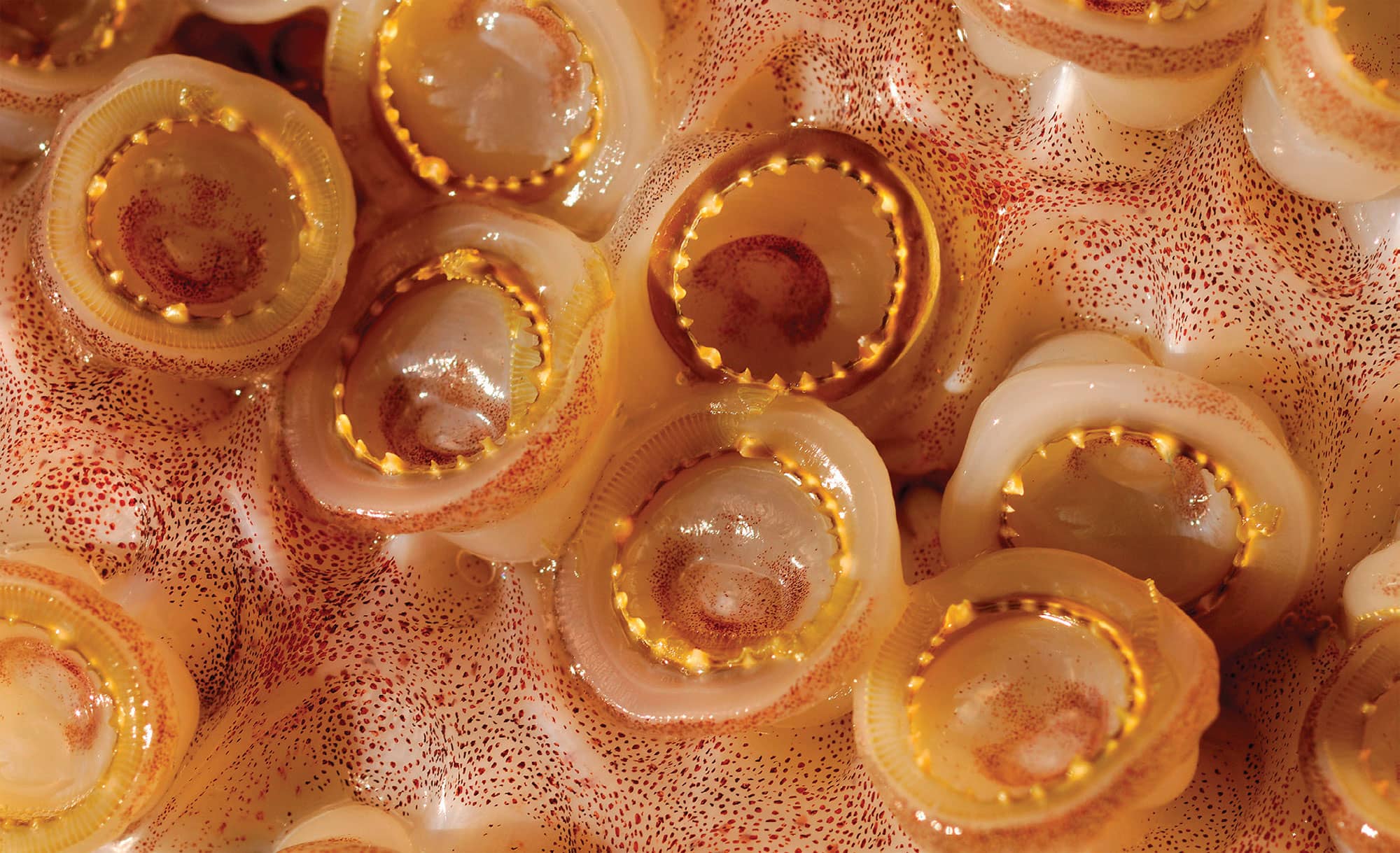
These squid suckers have a toothed ring of tough yet flexible protein that passively “bites” into the skin or scales of prey items to cut down shear forces.
HORNED OCTOPUS
Eledone cirrhosa
HORNED OCTOPUSES ARE SOLITARY ANIMALS. They readily enter lobster pots and prey on lobsters, crabs, and other trapped species. North Sea populations of horned octopus increased recently as some fish predators of octopus were overfished, and this has a cascade effect of reducing the commercial crab and lobster fisheries. Horned octopuses are commercially fished with bottom trawls and they are harvested on a large scale in the Mediterranean Sea. It is curious that they can be caught in trawls since they live in dens most of the day. They may pick up the low-frequency vibrations of the oncoming bottom trawl and then respond by jetting upward out of their den into the water column, which places them into the mouth of the fast-moving trawl net.
OCTOPUS OF BIOLOGICAL VALUE
The physiology and morphology of skin patterning have been studied in the horned octopus as a comparison to other octopuses that have richer and more diverse skin and patterning repertoires. Due to its relatively simple skin, the motor fields of chromatophores on the mantle have been mapped by stimulating nerve centers in the brain. The white spots in the skin are called leucophores and are useful for camouflage as well as taxonomic identification. Its name refers to a large protruding papilla above each eye that resembles a horn.
FAMILY |
Eledonidae |
OTHER NAMES |
Curled octopus (UK) |
TYPICAL HABITAT |
Sand, mud, broken rock, and rocky reefs 200–400 ft (60–120 m) depth on continental shelf |
SIZE |
Mantle length up to 71/2 in (19 cm) |
FEEDING HABITS |
Wide range of prey including shrimps, lobsters, crabs, brittle stars, polychaetes, gastropods, and fishes |
KEY BEHAVIORS |
Typical octopus bottom dweller living in dens and using camouflage while foraging |
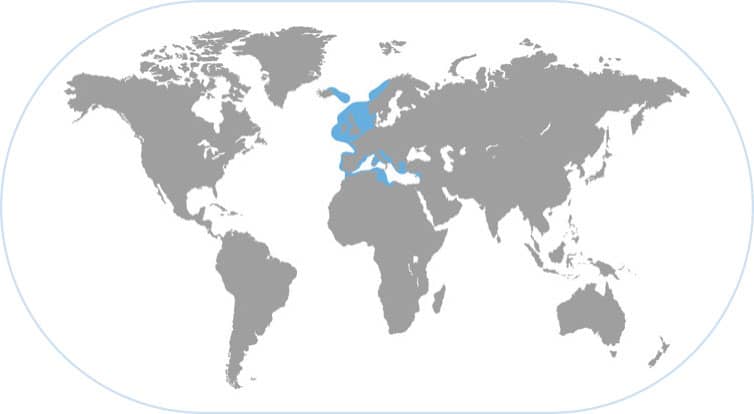

SIMPLE SEA-BED DISGUISE
This is a typical bottom-dwelling octopus that eats a large array of live prey. Its body patterning is quite drab compared to octopods that live in shallower, well-lit and diverse habitats. This octopus has only one series of suckers down each arm, whereas most octopus species have two series.
LESSER TWO-SPOTTED OCTOPUS
Octopus bimaculoides
THIS SHALLOW-WATER ADAPTABLE OCTOPUS is common in southern California and it lives not only amidst beautiful kelp forests and rock reefs but on muddy bottoms close to shore, an indication of its adaptability to visually and structurally diverse habitats. It forms its dens in existing crevices and holes in most habitats, but when residing in the flat muddy habitats this species constructs elaborate burrows that are lined with rocks, indicating an ability to manipulate the local environment in a clever and adaptive fashion. This species forages daily to feed on a wide range of live prey including shelled molluscs, shrimps, and crabs. Its camouflage in these habitats is superb.
FIRST CEPHALOPOD GENOME TO BE SEQUENCED
The first fully sequenced cephalopod genome ever published (in the journal Nature in 2015) and made available to the wide scientific community was Octopus bimaculoides, and it was chosen as the most suitable candidate because (1) it is typical in body form and behavior of the many species of octopus, (2) it is common and available to the research community in the USA, and (3) this species has large eggs and is relatively easy to rear or culture in captivity. The genome is very large, which was not unexpected given the complexity of the nervous system and behavior of the octopus, and hundreds of cephalopod-specific and octopus-specific genes were discovered, many of which showed elevated expression levels in specialized structures such as the skin, suckers, and nervous system. This landmark study lays the groundwork for a great deal of exciting and novel future research in many scientific disciplines.
FAMILY |
Octopodidae |
OTHER NAMES |
The California mudflat octopus |
TYPICAL HABITAT |
Temperate rock reefs and kelp habitats; muddy flats in shallow water |
SIZE |
Mantle length to about 4 in (10 cm) |
FEEDING HABITS |
Forages daily for bivalves, gastropods, shrimps, and crabs. |
KEY BEHAVIORS |
Day-active, sophisticated camouflage, sometimes constructs complex rock-lined burrows in mudflats |


BLUE-RINGED EYESPOTS
The distinctive eyespots, or ocelli (one on each side of the octopus), are displayed when the octopus is startled or threatened. Otherwise the ocelli are indistinguishable from the coloration of the rest of the body. Only a few octopus species have ocelli.
SOUTHERN BLUE-RINGED OCTOPUS
Hapalochlaena maculosa
WITH ITS IRIDESCENT FLASHING RINGS this octopus warns approaching predators of its toxicity. This is a small species and this defense tactic is quite unusual among cephalopods. The blue rings are hidden most of the time and in fact this is one of the best-camouflaged of octopuses, but when it is discovered by a predator it will change its appearance dramatically and this startles the predator and presumably makes it hesitate briefly so that the octopus can ink and jet away.
THE MOST VENOMOUS CEPHALOPOD
Not only does this octopus have venomous toxin in its salivary gland to paralyze large prey, but the potent neurotoxin tetrodotoxin (TTX) is also distributed in all body parts with high concentration in the arms followed by the abdomen and gills. A bite to a human can be lethal because the TTX produces respiratory arrest within minutes and immediate artificial respiration must be given for survival. Fortunately, this octopus is not aggressive and it requires a human to handle (or mishandle) the octopus before it will bite the person. So the simple solution is to heed the warning of the blue rings and not touch or manipulate this octopus species without great care. The mother invests TTX into her eggs so that the young are venomous upon hatching.
FAMILY |
Octopodidae |
OTHER NAMES |
Lesser blue-ringed octopus |
TYPICAL HABITAT |
Seagrass beds, sand and rubble, shallow subtidal reefs |
SIZE |
Mantle length up to 21/4 in (57 mm) |
FEEDING HABITS |
Forages nightly for small crabs and shrimp |
KEY BEHAVIORS |
Superb camouflage, flashing blue rings when startled or threatened |

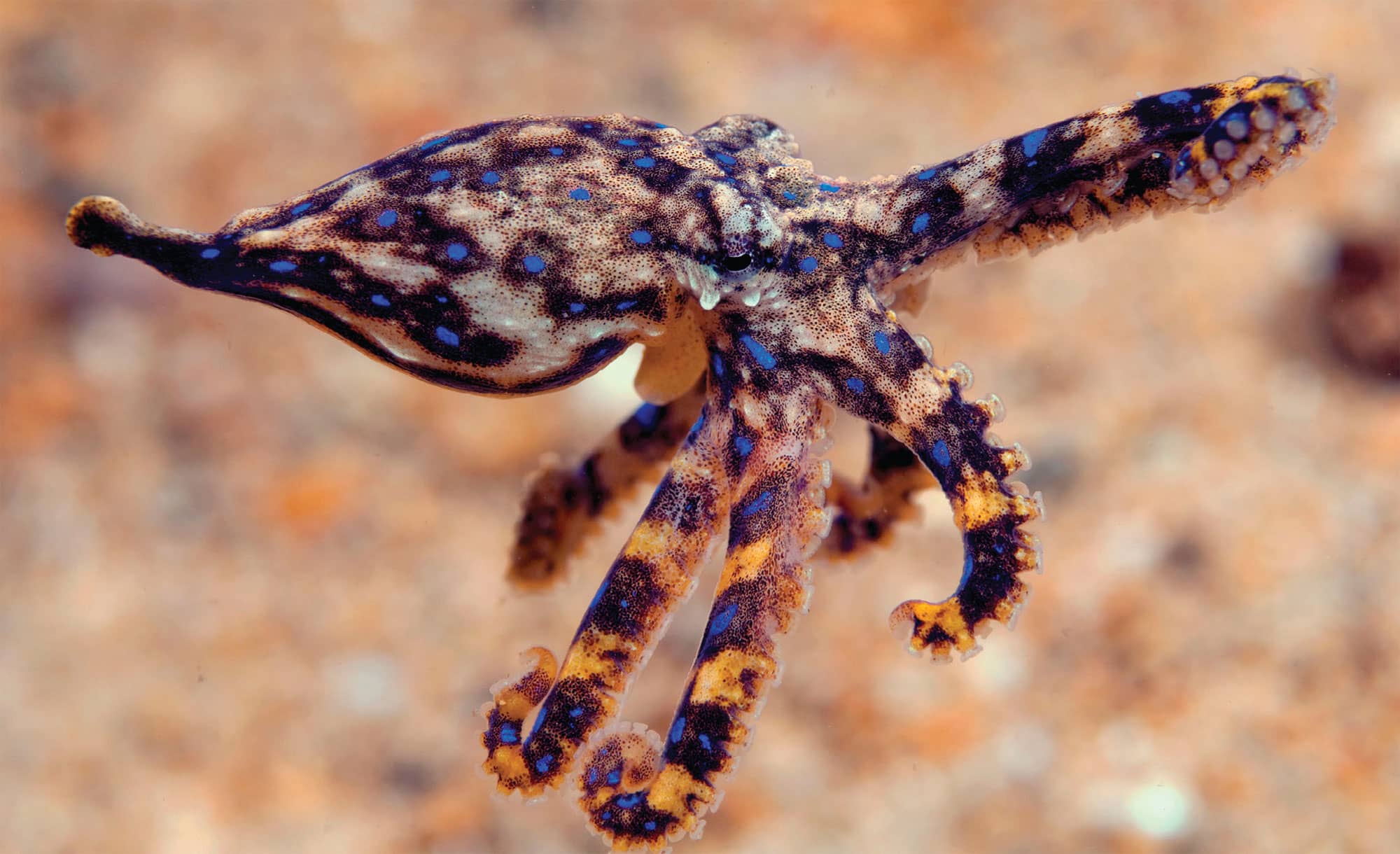
BLUE FOR DANGER
The threat display of flashing blue rings is highly conspicuous and is considered a warning display to deter close approach of predators. This display is honest because this octopus is extremely toxic to predators and to humans. The fast flashes are achieved by relaxation of the muscles above the iridescent rings; upon fast neural relaxation of those muscles the rings are suddenly exposed and appear bright blue within a second. Sometimes the iridescence is in rings or spots (above) or short stripes (below).
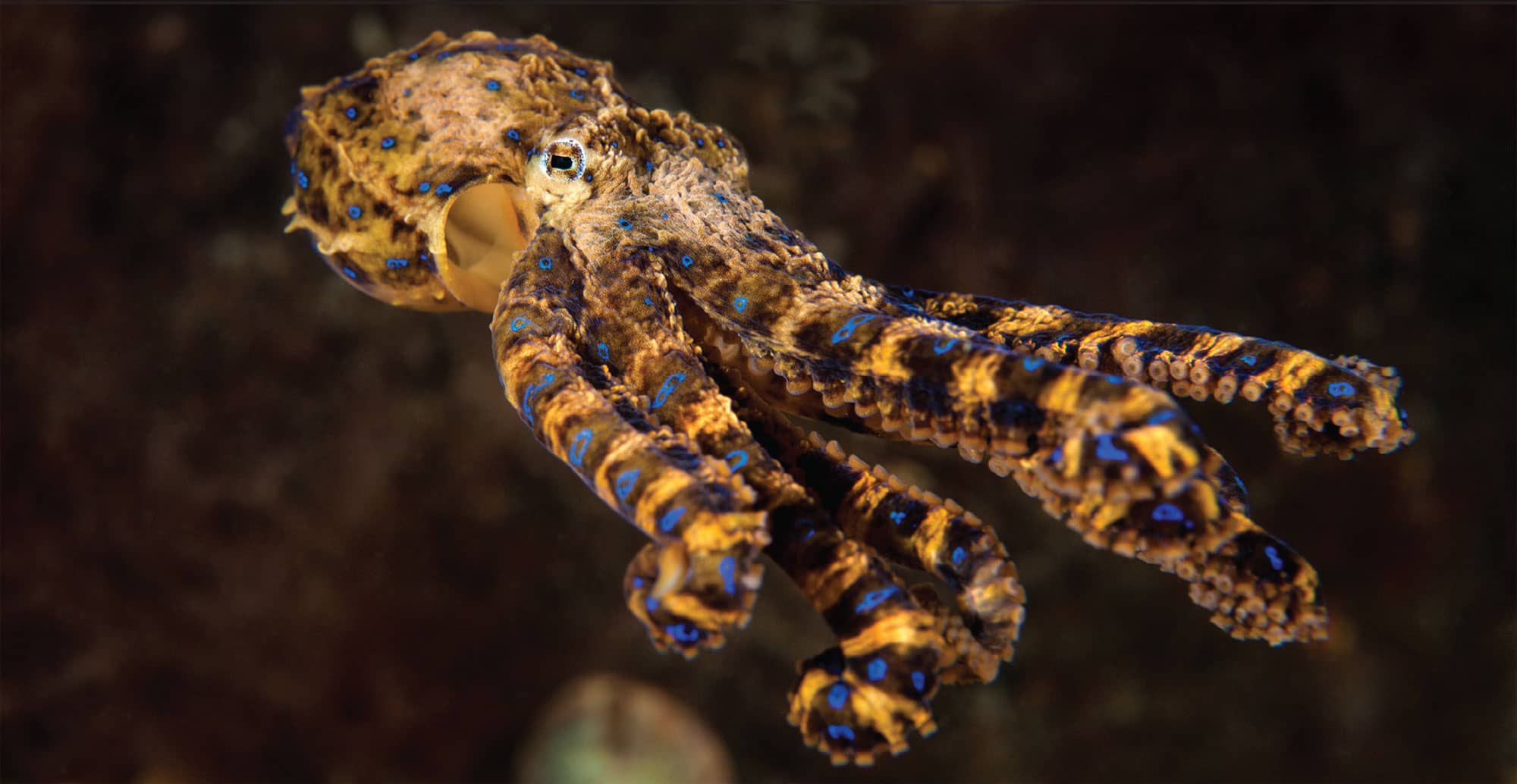
HAWAIIAN BOBTAIL
Euprymna scolopes
THESE SMALL AGGRESSIVE SAND DWELLERS have two particularly clever adaptations to living on the open sand plains around Hawaii. First, they bury in the sand to hide during the day, with only their eyes protruding (but well camouflaged); they also have a glue that keeps the sand in place on their topside, and they can instantly throw the sandy glue layer off to rapidly jet away from a predator or grab a shrimp. Second, they have a very large light organ in their mantle that helps them camouflage (via counterillumination) at night while swimming in the water column.
A KEY BIOMEDICAL MODEL
Their luminescent organ produces light with the common seawater bacterium Vibrio fischeri. Each morning the bobtail expels the bacteria from its light organ and then recruits new bacteria from the seawater during the day to start a new culture of fresh bacteria to create luminescence that night. The intriguing aspect of this is that most bacteria of the genus Vibrio are pathogens to many animals including humans: in the bobtail the bacteria are symbiotic—not pathogenic. Comparing Vibrio fischeri with the pathogenic Vibrio helps medical researchers learn more about the molecular signals that enable symbiosis versus pathogenesis, which could lead eventually to better antibacterial medicines. The genome of Euprymna scolopes is recently completed and the bobtail is relatively easy to culture so this may become the first cephalopod lab model for continuous culture.
FAMILY |
Sepiolidae |
OTHER NAMES |
Hawaiian bobtail squid, Mu he'e |
TYPICAL HABITAT |
Sandy substrates close to shore usually in shallow water |
SIZE |
Mantle length up to 13/16 in (3cm) |
FEEDING HABITS |
Mainly live shrimps during the night |
KEY BEHAVIORS |
Buries in sand during day; swims in water column at night using large bioluminescent light organ for counterillumination |
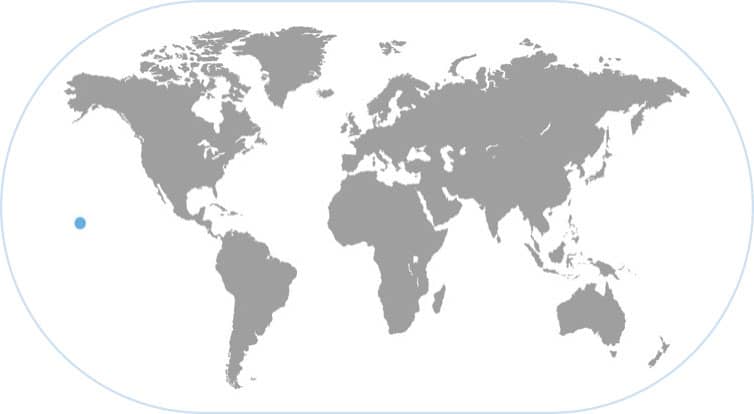
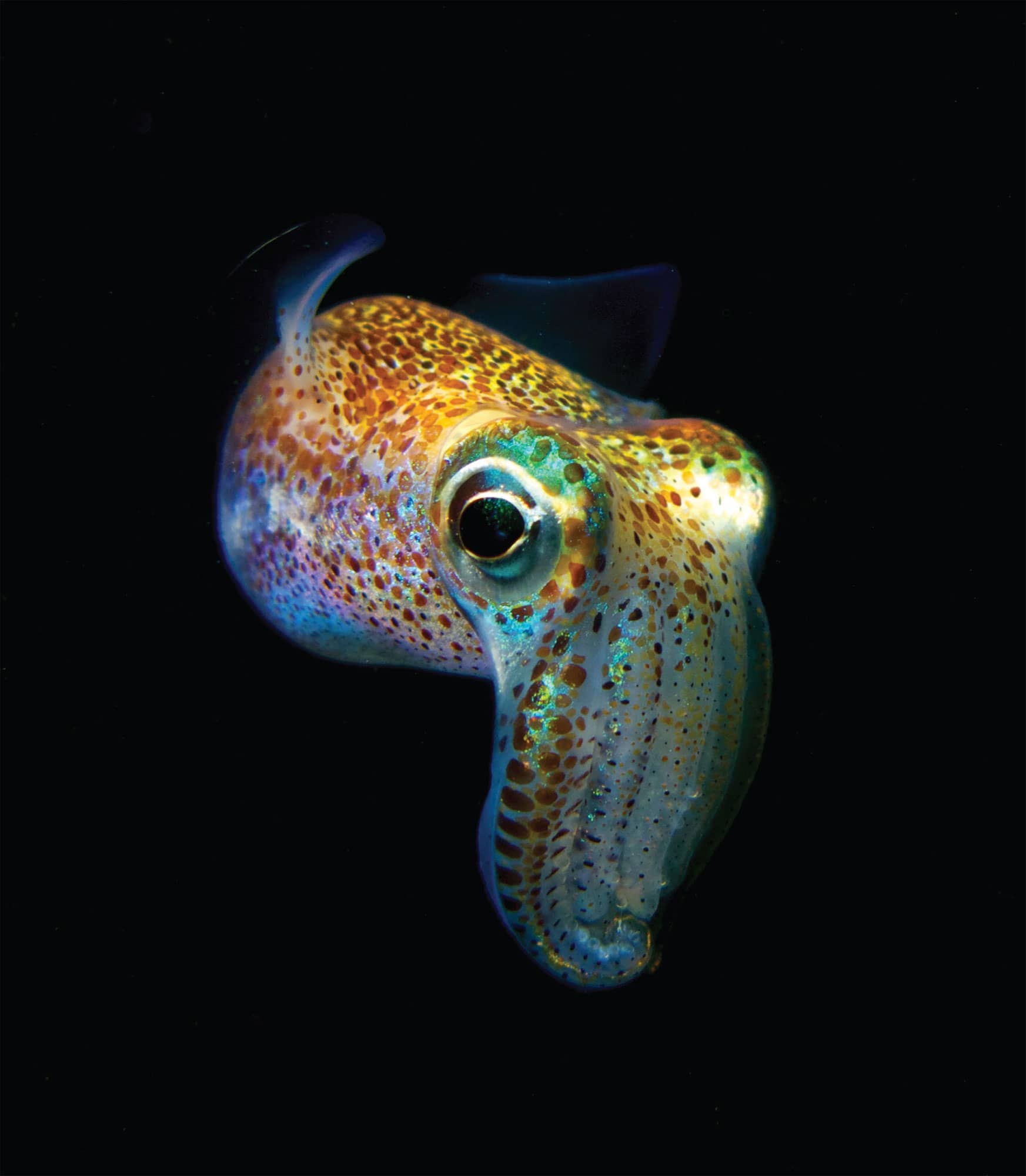
DAYTIME HIDING
This small bobtail is not technically a squid—it is in the order Sepiolida. It is fully adapted to a sand environment and hides in the sand all day then forages during the night using its bioluminescent organ for countershading camouflage. Note the large chromatophores and the iridescent splotches all over the body.
CAPE HOPE SQUID
Loligo reynaudii
LARGE MATING AGGREGATIONS OF HUNDREDS or sometimes thousands occur nearshore along the southernmost coast of South Africa every November and December. The mating system is dramatic and complex. The mating arenas are large and somewhat structured with a mating zone a few feet from the egg clumps in which mating pairs swim and mate. Between there and the egg clumps is the agonistic zone, in which lone large males and smaller sneaker males intercept the mating pairs as they move toward the egg clumps and try to displace the male consort or obtain a quick head-to-head mating. There is intense competition for mates and two distinct mating positions and sperm placement occur in this dynamic reproduction system.
A WELL-REGULATED FISHERY IN SOUTH AFRICA
Fishing Cape Hope squid is a relatively small industry that exports much of the catch to Europe. Most of the squids are captured by small jigging boats. Because of the mobility of these large loliginid squids the annual landings fluctuate a great deal based partly on large-scale changes in the Benguela Current. This species has been studied extensively to better understand these fluctuations and there is a good union between the fishing industry and research academia and government fishery managers. There is a cooperative closed fishery season during November so that sufficient egg laying and recruitment occur for this annual species.
FAMILY |
Loliginidae |
OTHER NAMES |
The chokka squid |
TYPICAL HABITAT |
Continental shelf at 30–650 ft (10–200 m) depth; sometimes offshore down to 1,150 ft (350m) |
SIZE |
Mantle length up to 16 in (40 cm) |
FEEDING HABITS |
Paralarvae feed on copepods and adult squids feed mainly on fishes but also on crustaceans and polychaetes |
KEY BEHAVIORS |
Schooling near the substrate during the day, swimming in water column at night and feeding. Complex reproductive behaviors |


EGG LAYING
A large male is hovering above an egg clump and guarding his female mate, who is inserting an egg finger into the clump. She will then leave the egg clump and the pair will swim together several feet off the substrate to mate, then she will descend again to insert another egg finger, containing 100–300 eggs. This sequence can be repeated a dozen times over several daylight hours.
VEINED SQUID
Loligo forbesii
THIS LARGEST OF THE LOLIGINID SQUIDS has a widespread distribution around Europe but also occurs around the islands of Madeira and the Azores to the west of Portugal. They are preyed upon by pygmy sperm whales, orca (killer) whales, porpoises, seals, and seabirds. Like other loliginids, they lay egg capsules (similar in size to a human finger) in egg clumps that are embedded in the sand in shallow water inshore.
SIGNIFICANT FOR FISHERIES AND BIOMEDICINE
These large squids are fished by bottom trawl in European locations and by jig in the islands of Madeira and the Azores and are a favorite menu item throughout their distribution. They also have the largest nerve fibers known to neuroscience: up to 1.5 mm in diameter. Thus they have been used for many years (mainly in Plymouth, England) as models for how neurons work. This species has been cultured in the laboratory to determine feasibility for making it more widely available to neuroscientists. The growth rate is very fast but full adult size was not attained; moreover, they are active carnivores, thus the challenge of providing live crustaceans and fishes as food render this species too expensive to culture for biomedicine or commercial mariculture.
FAMILY |
Loliginidae |
OTHER NAMES |
Forbes squid, Calamar veteado |
TYPICAL HABITAT |
Temperate species that lives mostly nearshore on the continental shelf over sand, mud, or seagrass; in the Azores it lives along steep slopes of the islands from 160–3,300 ft (50–1,000 m) |
SIZE |
Commonly 8–12 in (20–30 cm) mantle length but can be triple that size; males are larger than females |
FEEDING HABITS |
Feeds on small fishes, crustaceans, and polychaetes; in some locations it feeds on fishes such as cod, whiting, mackerel, and sand eels |
KEY BEHAVIORS |
Schooling near the bottom or on slopes, sometimes known from telemetry data to “glide” on upwelling currents |

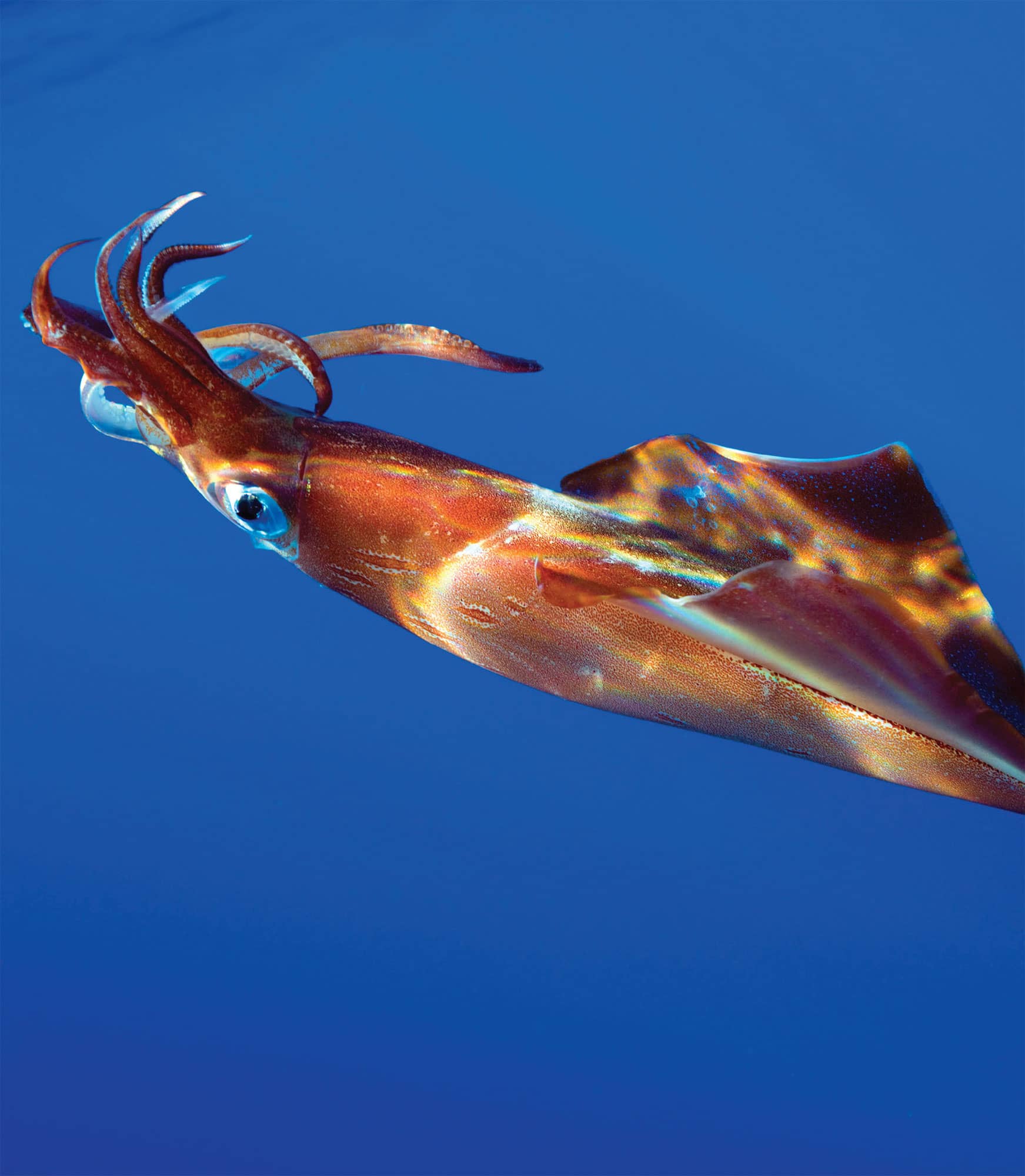
DEEP-SEA EUROPEAN SQUID
This large and powerful loliginid is a schooling species that is fished commercially in many locations around Europe and tends to prefer deeper waters than others in this family of squids. Note the streaks of “flame markings” along the ventral mantle.
JEWEL SQUID
Stigmatoteuthis arcturi
THE JEWEL SQUID—SO CALLED BECAUSE of the bioluminescent photophores that cover its body—occurs in tropical and subtropical waters of the North and South Atlantic. Their feeding habits are unknown but they are prey to many major predators such as sperm whales and other odontocete cetaceans, various seabirds, sharks, tunas, and lancetfishes. The vertical posture of the jewel squid is rather unusual but an adaptation that allows it to simultaneously look up, down, and laterally. Very little is known about this particular species but the other closely related histioteuthids are all widely distributed in the world’s oceans and they all have unusual eyes.
ASYMMETRIC EYES
All squid species in the family Histioteuthidae have markedly asymmetric eyes. The right eye is reasonably “normal” but the left eye is much larger and tubular in shape, with the lens (and thus the eye) pointing at a distinct angle toward the surface. It is thought that this allows the squid to spot prey or predators that are silhouetted against the dimly lit waters above it.
FAMILY |
Histioteuthidae |
OTHER NAMES |
Strawberry squid |
TYPICAL HABITAT |
Surface waters to 3,300 ft (1,000 m) depth in the open ocean |
SIZE |
Mantle length to about 8 in (20 cm); males slightly smaller |
FEEDING HABITS |
Unknown but probably a mix of small crustaceans and fishes |
KEY BEHAVIORS |
Bioluminescence; strange body posture to enable it to view upward with one eye and laterally and downward with the other |


RED GLOW
The many large photophores set in bright red skin are the reason for the common name of the jewel squid; they are sometimes referred to as strawberry squid for the same reason.
JAPANESE FIREFLY SQUID
Watasenia scintillans
THIS VERTICALLY MIGRATING OPEN-OCEAN SQUID is small in size but colorful in two respects: it has an intricate array of luminescent bluish photophores; and it also seems to be able to perceive different colors within the blue and green range. This squid “lives in the dark” by staying very deep during the day (at about 1,000 ft (300 m) where downwelling sunlight is very weak) and migrating to surface waters during the night. In so doing it makes itself vulnerable to attack from below, so its extraocular photoreceptors on the head detect the amount of downwelling light and then regulate the amount of ventral luminescence it displays to hinder detection or recognition of its silhouette as viewed by predators beneath it.
COLOR VISION
Cephalopods are thought to be colorblind. However, an exception is the firefly squid, which has three visual pigments located in different parts of the retina, each having distinct spectral sensitivities. All are in the blue and green portions of the light spectrum, which likely enables firefly squid to discriminate different shades of blue and green but not other colors. This makes ecological sense since they live in dimly lit habitats both day and night, and sources of light would be bioluminescence (which is in the blue spectrum) and starlight or moonlight that is filtered by many feet of seawater, also leaving mostly blue wavelengths.
FAMILY |
Enoploteuthidae |
OTHER NAMES |
Sparkling enope squid |
TYPICAL HABITAT |
Oceanic. Lives during the day at the mesopelagic boundary about 1,000 ft (300 m) deep; migrates vertically to near surface each night to feed |
SIZE |
Mantle length up to 23/4 in (7 cm) |
FEEDING HABITS |
Copepods during paralarval stage; amphipods, euphasids, and fishes in adult stages |
KEY BEHAVIORS |
Daily vertical migration of several hundred feet; well- developed bioluminescence. Moves inshore to shallow water to spawn. Only cephalopod with color vision. |
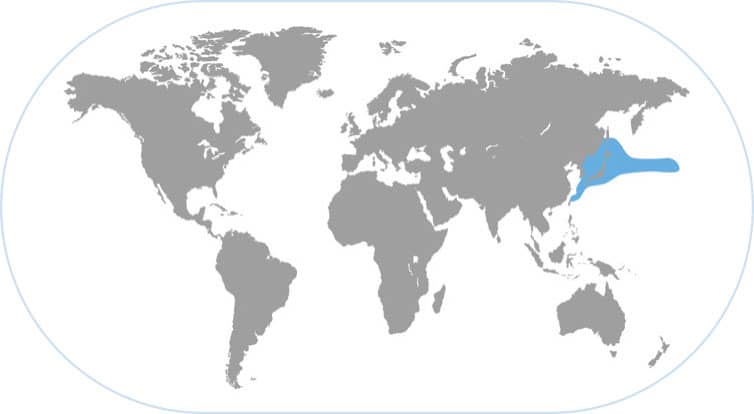
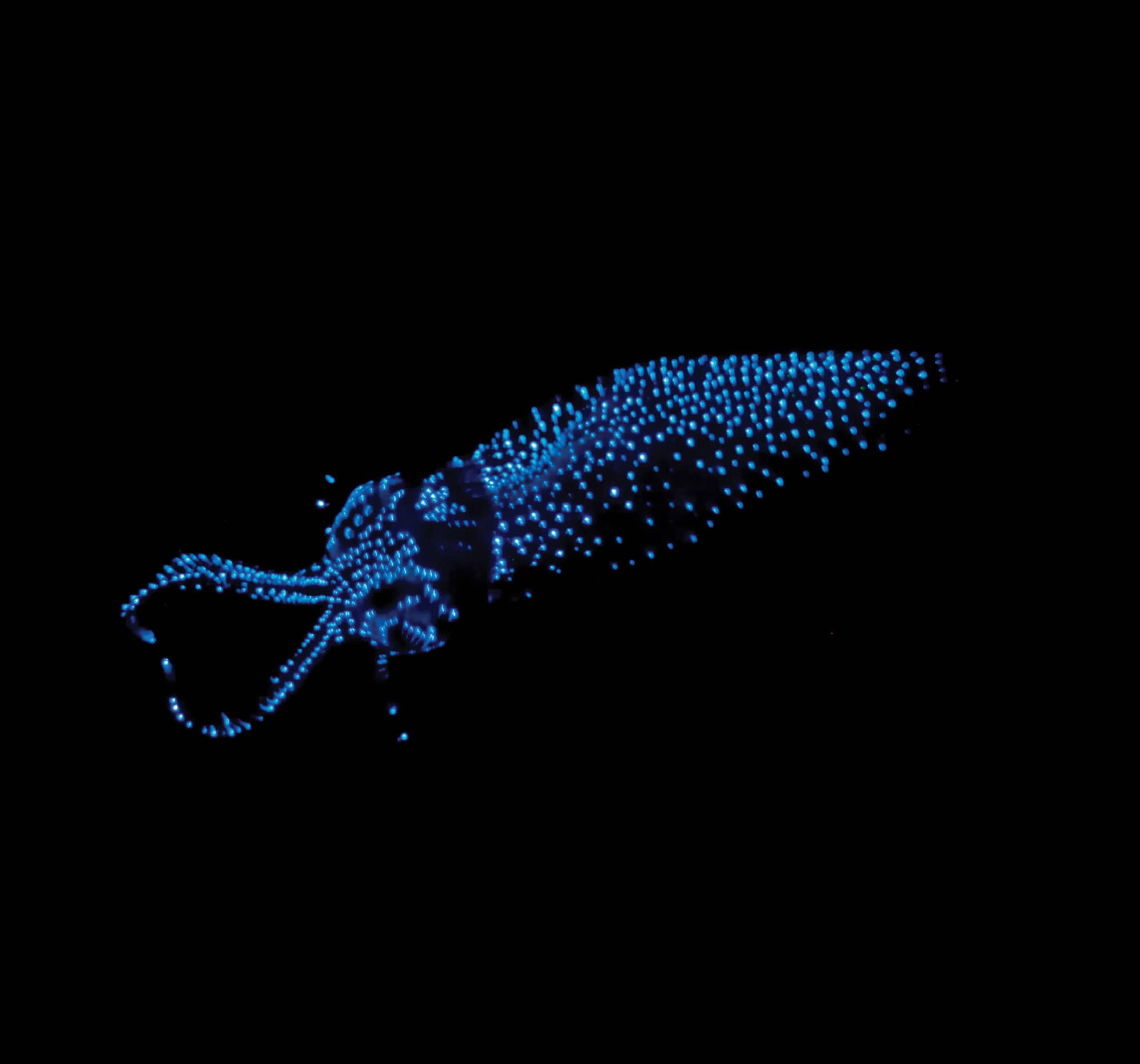
LUMINOUS BLUE DISPLAYS
The firefly squid is famous for its sparkling displays on the shores of Toyama Bay, where squids gather to mate and spawn, and currents push them in huge abundance into surface waters. Their bioluminescence, emanating from more than 800 photophores on their body surface, illuminates the water surface in electric blue.